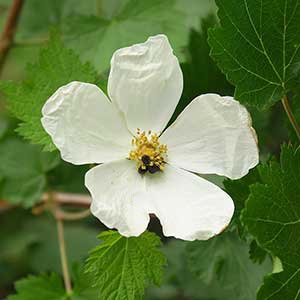Rubus bartonianus
Rubus vestitus
Barton's raspberry, bartonberry
European blackberry
erect, sparsely short-hairy, glabrescent, eglandular, not pruinose.
biennial, arching, usually densely, sometimes moderately, hairy, usually eglandular, sometimes sessile- to short-stipitate-glandular, not pruinose;
prickles moderate to dense, recurved to erect, slender, 3–10 mm, broad-based.
deciduous, simple;
stipules lanceolate, 4–6 mm;
blade cordate to broadly ovate, (2–)2.5–4(–5) × (2.5–)3.5–4.5(–5.5) cm, base deeply cordate, 3–5-lobed, lobe apices acute to obtuse, margins coarsely doubly dentate, abaxial surfaces glabrous or sparsely hairy, eglandular or sparsely stipitate-glandular.
deciduous or ± persistent, palmately compound;
stipules filiform to linear, 5–15 mm;
leaflets 3–5, terminal usually suborbiculate to orbiculate, sometimes broadly elliptic, 4–9 × 4–8 cm, base rounded to shallowly cordate, unlobed, margins moderately to coarsely serrate, apex acute to cuspidate, abaxial surfaces with hooked prickles on midvein, densely white-gray to gray-green tomentose, eglandular or obscurely short-stipitate- to sessile-glandular along midveins.
1-flowered.
terminal, 7–35-flowered, cymiform or thyrsiform.
moderately hairy, eglandular or sparsely stipitate-glandular.
prickles moderate to dense, recurved to erect, densely hairy, moderately to densely stipitate-glandular.
bisexual;
petals white, obovate, (15–)20–25 mm;
filaments filiform;
ovaries glabrous, styles clavate, villous.
bisexual;
petals pink to magenta, elliptic to suborbiculate, 6–12(–15) mm;
filaments filiform;
ovaries apically hairy.
deep red, hemispheric, to 1 cm;
drupelets 10–30, coherent, separating from torus.
black, globose, 1–1.5 cm;
drupelets 15–40, coherent, separating with torus attached.
= 28.
Rubus bartonianus
Rubus vestitus
Of conservation concern.
Rubus bartonianus is distinguished from the other flowering raspberries within its geographic range by its erect, unarmed stems, relatively small, simple leaves with acute to obtuse lobes, deeply cordate bases, sparsely hairy or glabrous abaxial surfaces, relatively large flowers with white petals, and densely long-hairy, clavate styles. The leaves superficially resemble those of Acer glabrum or some species of Ribes.
Rubus bartonianus is most similar to R. neomexicanus but especially R. deliciosus. The species is known only from the Snake River Canyon of Idaho and Oregon.
(Discussion copyrighted by Flora of North America; reprinted with permission.)
Rubus vestitus can be distinguished, especially from the closely related R. bifrons and R. ulmifolius, by its long-stipitate-glandular hairs, particularly in the inflorescence, and terminal primocane leaflets that are typically suborbiculate and abaxially densely tomentose. Rubus allegheniensis can possess similar glandular hairs; it does not have pink petals, thyrsiform inflorescences, and rounded and abaxially densely tomentose, often whitened terminal leaflets.
Rubus vestitus has not yet been found in Washington, but it is likely there. Because of the overall similarity of R. vestitus to R. bifrons, it is possible that this potentially weedy species is widespread, but rare and possibly overlooked, occurring as far south as California. In Oregon, R. vestitus prefers shady habitats (B. Wilson, pers. comm.).
(Discussion copyrighted by Flora of North America; reprinted with permission.)
- Local floras:
BC,
OR,
WA
- Local Web sites:
Flora NW,
PNW Herbaria
WildflowerSearch
iNaturalist (observations)
USDA Plants Database
- LBJ Wildflower Center
- SEINet
- Plants of the World Online
- Encyclopedia of Life
- Wikipedia
- Google Image Search


